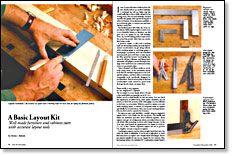All About Measuring and Marking Jigs

Every woodworking project, from simple to complex, involves measuring and marking. In projects that lean toward complex, standard marking tools don’t always suffice. In these cases, a jig or fixture can help.
The Basics:
• Custom tools for repeated tasks: Make a dedicated marking tool to your requirements.
• Beyond the basic curve: Jigs can produce uncommon curves.
• Designing furniture: Drawing aids expand your design options.
Custom tools for repeated tasks
The standard measuring and marking tools — a tape measure, a ruler, a compass, a pencil, and a marking knife to name a few — are some of the most used tools in our shop. But these tools take us only part of the way. Sometimes a project requires a measurement or mark that can’t be accomplished without the aid of a jig or fixture.
Laying out dovetails, mortises, and tenons would be most difficult and time-consuming without marking aids. For example, there’s no reason to reach for a bevel gauge, and set it to your dovetail angle every time, when you can build a custom bevel gauge from wood that has that exact angle built in.
No discussion of measuring and marking jigs should leave out story sticks. Story sticks trade the by-the-number tape measure approach for direct transfer of dimensions to ensure accuracy and uniformity in your measurements. Key dimensions of a project are marked on one or more sticks, which are then used to apply marks to workpieces. Often story sticks are used when a project requires a measurement to be reproduced multiple times, such as when marking the distance to a mortise on a chair leg,
Beyond the basic curve
With shopmade special measuring and marking fixtures we can draw subtle curves, divide lines into equal segments and circles into equal arcs. With a tin can and a length of string you can construct a sweet-acting cam.
The ellipse, or a portion thereof, is one of the most graceful curves used in woodworking and furniture design. Drawing an ellipse, however, is an intriguing layout problem. Woodworkers have solved the problem in several different and creative ways — using a piece of string, a framing square, or an elliptical drawing jig with an arm that moves across two axes.
Designing furniture
They say the best projects are built twice, first on paper and then with wood. Sure, you can follow a pattern someone else has created. But woodworking gets really interesting and challenging when you begin to design your own projects. And there is no more important skill in design than the ability to draw. Full-size drawings of your projects head off potential problems, allow you to get a sense of proportions and size, and to create patterns and templates for the piece.
Fine Woodworking Recommended Products

Woodriver Circle Cutting Jig

Hedgehog featherboards

Double Sided Tape





















Log in or create an account to post a comment.
Sign up Log in